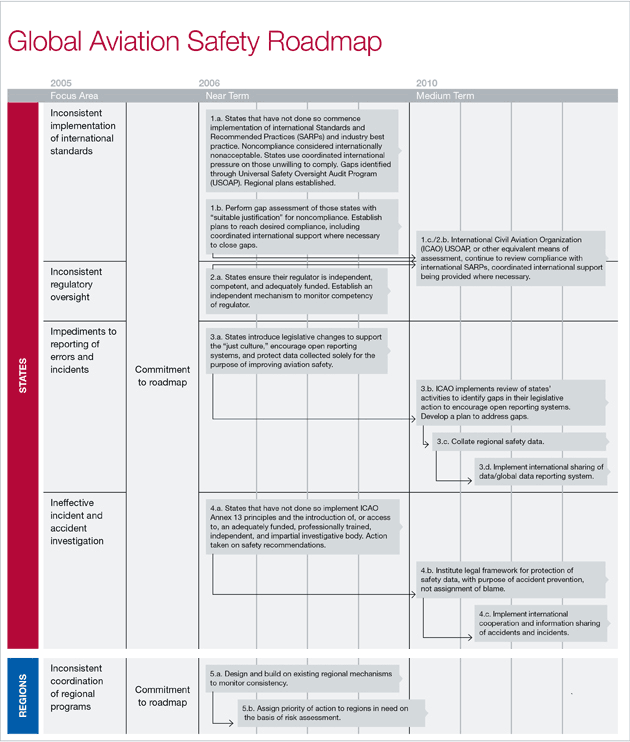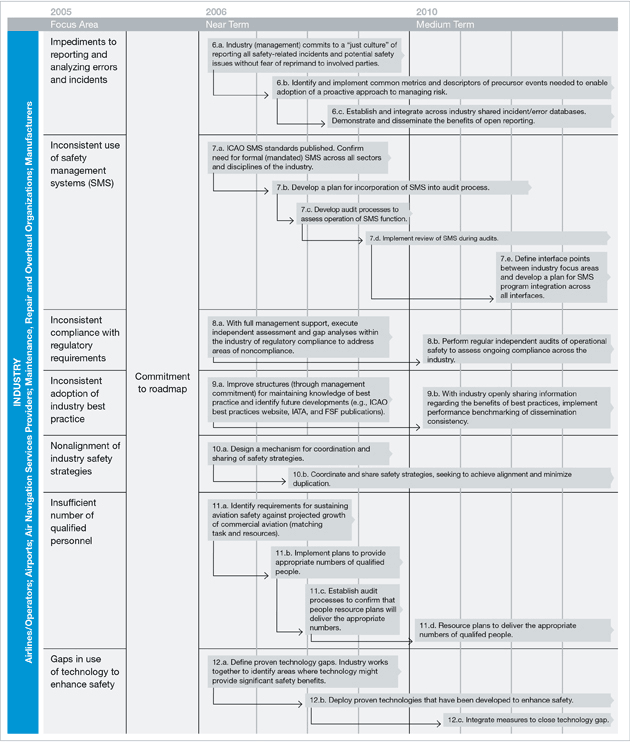

Working with industry, Boeing has contributed to the development of a safety plan that focuses on promoting a safe and efficient global air transportation system. Its main objective is to help all regions of the world achieve the high levels of excellence maintained by the regions with the best aviation safety performance.
By Terry McVenes, Senior Manager, Aviation System Safety,
and
Gerardo M. Hueto, Program Manager of Regional Safety
The primary objective of the safety roadmap is to provide a common frame of reference for all stakeholders.
This article outlines how Boeing is working with industry to further reduce the accident rate in various regions of the world through the creation and implementation of a Global Aviation Safety Roadmap.
A COMMITMENT TO SAFETY
Boeing believes that safe flight should be a basic expectation of citizens everywhere. Enhancing aviation safety performance depends on industry and government working together to focus their combined energy on the most significant problems.
Working with the members of an Industry Safety Strategy Group (ISSG) — International Air Transport Association, Airbus, Flight Safety Foundation, Airports Council International, Civil Air Navigation Services Organization, and International Federation of Air Line Pilots’ Associations — Boeing has developed a Global Aviation Safety Roadmap for the International Civil Aviation Organization (ICAO). ICAO has aligned its Global Aviation Safety Plan with the roadmap, including activities from its Cooperative Development of Operational Safety and Continuing Airworthiness Program (COSCAP).

The Global Aviation Safety Roadmap:
- Is the primary guide for states and industry to work together to improve global aviation safety.
- Requires that a logical process be followed so regions are always investing their energy in the most critical actions.
- Provides metrics and measurement that enable rigorously managed improvement.
- Channels efforts through existing mechanisms, not new bureaucracies.
THE NEED FOR A SAFETY ROADMAP
Efforts to improve safety have been most successful when industry and government have worked together. Better use and coordination of industry and government resources can reduce or eliminate factors that could possibly lead to accidents.
Achieving the next major breakthrough in reducing regional accident rates requires moving beyond the traditional government-industry model, with its adversarial position of regulator versus the regulated. The ISSG opted to develop an action plan of global dimensions that clearly identified the roles played by regulators and industry, while emphasizing their complementary nature.
ABOUT THE GLOBAL AVIATION SAFETY ROADMAP
The Global Aviation Safety Roadmap is focused on reducing accident rates, harmonizing best practices worldwide, and applying resources wisely. It provides a means to ensure that safety initiatives throughout the world deliver improved safety by coordinating efforts, thereby reducing inconsistency and duplication.
The primary objective of the safety roadmap is to provide a common frame of reference for all stakeholders, including states, regulators, airline operators, airports, aircraft manufacturers, pilot associations, safety organizations, and air traffic service providers. The roadmap coordinates and guides safety policies and initiatives globally.
The roadmap is based upon high-level principles that have been accepted by industry as vital to the enhancement of safety levels within global commercial aviation. It recognizes that there will always be reactive elements in safety management, but emphasizes near- and midterm mileposts against which stakeholders must plan for the future and gauge their progress (see fig. 1).
Figure 1: The roadmap
The Global Aviation Safety Roadmap is designed to coordinate and guide safety policies and initiatives worldwide to reduce accident risk.
[+] Enlarge
The roadmap is not designed to provide detailed guidance to achieve a desired endpoint. Depending upon specific developments and circumstances, there may be multiple routes to gain the same objective. The importance and utility of the roadmap is to ensure that stakeholders’ collective efforts converge upon common objectives.
ROADMAP FOCUS AREAS
The Global Aviation Safety Roadmap has 12 focus areas grouped into three sets, according to the primary aviation sector that is most responsible for carrying out measures to achieve them.
States
- Consistent implementation of international standards.
- Consistent regulatory oversight.
- No impediments to reporting errors and incidents.
- Effective incident and accident investigation.
Regions
- Consistent coordination by both states and industry across several states.
Industry
- No impediments to reporting and analyzing errors and incidents.
- Consistent use of safety management systems.
- Consistent compliance with regulatory requirements.
- Consistent adoption of industry best practices.
- Alignment of global industry safety strategies.
- Sufficient number of qualified personnel.
- No gaps in the use of technology to enhance safety.
Organizing the focus areas in this manner emphasizes that the roadmap is intended to be a joint effort at a regional level.
IMPLEMENTING THE ROADMAP
Teams in regions throughout the world can use a step-by-step process to develop safety enhancement plans in accordance with the roadmap focus areas (see fig. 2). Depending on the region, these teams are made up of regulators, airline managers, pilots, manufacturers, and airport managers.
Figure 2: Regional safety plan development process
The roadmap provides regional safety teams with clearly defined implementation methods.
As part of the Global Aviation Safety Roadmap implementation, Boeing and other members of the ISSG are conducting regional workshops designed to develop viable, self-sustaining industry-government regional safety teams and implementation plans throughout the world. The workshops build a rigorous foundation that regional teams are using to develop sustainable, detailed regional plans.
SUMMARY
Boeing is committed to further reducing the accident rate in all regions of the world and has helped lead the creation of the Global Aviation Safety Roadmap as well as its global implementation. The roadmap is a blueprint for coordinating and guiding safety policies and initiatives worldwide to reduce the accident risk for commercial aviation, avoid duplication of efforts and uncoordinated strategies, and encourage close industry and government cooperation on common safety objectives.
For more information, please contact Terry McVenes or Gerardo Hueto.

By Paul Russell, Chief Engineer, Aviation System Safety/U.S. and European Safety Programs
For years, members of the aviation industry have studied accidents after the fact in an attempt to determine why they occurred. During many of these studies, investigators were able to identify the presence of a factor or factors that contributed to the accident within the data being studied. If these factors could have been identified sooner — from incident or normal operational data — actions could have been implemented to reduce or eliminate them and possibly prevent an accident.
Many people within industry are now evolving to a more predictive approach, examining aviation operational data to identify less obvious or emerging patterns and potential conditions before accidents occur. The approach relies on all aviation stakeholders freely sharing, combining data, protecting proprietary data, and adhering to nonpunitive ground rules.
Major advances in the collection and sharing of routine operational data are helping operators enhance the safety of their own operations. Two examples are Flight Operations Quality Assurance (FOQA) and Aviation Safety Action Partnerships (ASAP). The Aviation Safety Reporting System (ASRS) of the U.S. National Aeronautics and Space Administration, which collects voluntary reports from pilots, is another system designed to identify safety issues before they become accidents.
Under the newly developed Aviation Safety Information Analysis and Sharing program, all of the data that is collected by the U.S. Federal Aviation Administration (FAA), as well as data collected by operators through FOQA/ASAP, can be analyzed to identify possible safety issues. Digital data such as FOQA is also routinely trended to evaluate the effectiveness of safety enhancements that have been implemented and to identify degradation of system safety metrics.
Data-mining techniques are being developed and used on the text of ASAP and ASRS reports to identify possible safety issues that are being encountered by flight crews, air traffic controllers, maintenance personnel, and other participants in the air transport system.
There is growing recognition within the aviation community that these proactive approaches can be effective in enhancing the safety of the global air transportation system.
An example of this data-merging capability is a study recently completed on unwarranted terrain warnings that were being experienced during approaches to some mountainous terrain airports. Although individually these alerts were harmless events, there was the very real potential that flight crews could become desensitized to the warnings and not respond rapidly to a valid alert. One of the areas identified for investigation was the approach to Oakland International Airport in California.
The study combined FAA radar data, FOQA data, ASRS data, weather data, air traffic control procedures, and minimum vectoring altitude maps for a complete and comprehensive analysis of the situation. The study identified the factors that were contributing to the warnings and developed three safety enhancements that are expected to reduce the false alerts by more than 90 percent. The study is now being expanded to other airports throughout the United States on a priority basis.
For more information, please contact Paul Russell.




